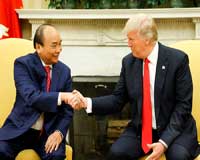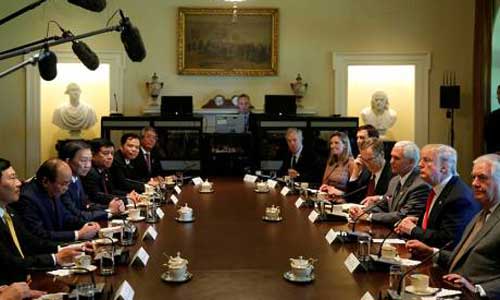"To sustain its export-driven economy and minimise the impact of US withdrawal from the TPP, Vietnam is placing a great thrust on the increased trade relations with the US, which is its largest export market. Vietnam and the US have recently signed business deals worth US$8 billion, in the sectors such as aircraft engines and development of power generation capabilities, along with hospitality, science and technology, academia and energy."

To sustain its export-driven economy and minimise the impact of US withdrawal from the TPP, Vietnam is placing a great thrust on the increased trade relations with the US, which is its largest export market. Vietnam and the US have recently signed business deals worth US$8 billion, in the sectors such as aircraft engines and development of power generation capabilities, along with hospitality, science and technology, academia and energy. The trade tie is expected to generate 23,000 American jobs and help in reducing the US trade deficit with Vietnam, which stood at almost US$32 billion in 2016.
Trade stats

Trade between the two countries has been witnessing 20 percent growth annually since 2001, with 2016 trade reaching US$47 billion – 33.5 times higher than 2001 figures. Vietnam is US’s 16thlargest trade partner and the fastest-growing market for US exports. Trade between the two nations is however tilted towards Vietnam. In 2016 and 2015, Vietnam’s trade surplus stood at US$32 billion and US$31 billion respectively. In the first four months of 2017, US accounted for 20 percent of Vietnam’s exports, an increase of 8.7 percent from the same period last year. Major export items included textile-garment, footwear, computers, seafood, farm products, timber and timber products, electronics and components.
Deals sealed in 2017
In the recent exchange, deals worth U$8 billion were signed between the two countries. General Electric signed its largest single combined sale with the country worth US$5.58 billion for power generation, aircraft engines, and services. The agreement includes 20 jet engines made by CFM International, a joint venture of GE and Safran for VietJet Aviation. Also included is a 12-year engine service contract for 100 Boeing 737 MAX aircraft that VietJet has ordered. VietJet also signed a US$1 billion deal with GE Capital Aviation Services for aircraft financing.
In the power sector, GE signed an MoU to build two 750-megawatt gas-fired turbine power plants in conjunction with state energy group Petro Vietnam. The deal also included joint development agreement for an 800-megawatt wind power facility. Caterpillar and its Vietnam subsidiary agreed to provide generator management technology for more than 100 generators in Vietnam. The remaining deals focused on hospitality, science and technology, academia and energy.
TPP without the US
As is the known fact that Vietnam would have been one of the major beneficiaries of the original TPP’s reduced tariffs. TPP including US would have led to an increase in US investments and help Vietnam position itself as a viable alternative to China for low-cost manufacturing. However, with the new US administration favouring bilateral trade deals rather than multilateral, few TPP member countries are pushing to revive the agreement without the US.
Vietnam had brought in changes in state-owned enterprises and deregulated key sectors such as finance, telecommunications, and retail to gain increased access to the US market. Even without the US, Vietnam believes that a renegotiated TPP will be feasible as TPP focused not only on market access, but also on labour reforms, transparency, IP protection, and anticorruption, which would help modernise its economy. The country will also benefit from increased market access in new members and a deeper integration in global supply chains. TPP11 will allow member states reduce their dependence on China, which backs the Regional Comprehensive Economic Partnership (RCEP), which is a 16-nation trade pact that includes the Association of Southeast Asian Nations (ASEAN), along with China, Australia, India, Japan, South Korea, and New Zealand.
Trade outlook
Trade experts predict exports to grow over 13 percent in 2017 driven by acceleration in global trade and higher import of raw materials and electronic parts. Largest export markets will continue to be the US, EU, China, and Japan accounting for 22 percent, 18 percent, 12 percent, and 8 percent respectively of total exports.












